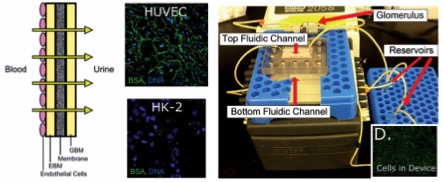Endothelial to Mesenchymal Transformation Mechanobiology

EndMT begins when a subset of endothelial cells delaminate from the cell monolayer and lose cell-cell contacts and endothelial markers. At the same time, these cells gain mesenchymal markers, develop an invasive and migratory phenotype, remodel the extracellular matrix (ECM), and secrete cytokines that influence resident cell populations. This project focuses on identifying the role of mechanobiology on endothelial to mesenchymal transformation (EndMT) and EndMT-derived fibroblast behavior. EndMT was first observed in embryonic heart valve development, but more recent studies have shown that mesenchymal transformation also occurs in tissue homeostasis, such as wound healing, and in adult pathologies including cancer, cardiac fibrosis, and calcific aortic valve disease. This project uses microfluidics, in vitro primary cell culture models, and computational simulations to determine the biological, chemical and mechanical cues that influence EndMT and EndMT-derived activated fibroblast behavior. The quantitative and qualitative knowledge gained from both the experiments and the computational modeling is an important part of the fundamental research that will lead to novel therapeutic regimes for endothelial cell-associated diseases.
In Vitro Gastrointestinal Tract

Metal oxide nanomaterials are currently used in food and food packaging, but the relationship between metal oxide nanoparticle ingestion, gut microbial populations, and intestinal function has not been established. This project studies how a broad class of nanomaterials interact with the human body and tests the interactions between consumed materials, the microbiota, and human gastrointestinal (GI) cells. The ultimate goal of this work is to determine if and how ingested metal oxide nanoparticles alter microorganism populations and intestinal function. A model of the GI tract and a panel of functional assays have been developed, and preliminary data shows that dietary doses of pristine metal oxide nanoparticles decrease mineral, glucose, and lipid absorption. This system models upper GI conditions to provide insight into nanoparticle-biological interactions. This valuable information is necessary for health and safety decisions and will inform both researchers and consumers.
Kidney on a chip

The kidneys are responsible for blood filtration, osmoregulation, and reuptake, and receive ~25% of cardiac output. This project aims to create a physiologically realistic in vitro model of the proximal tubule and glomerulus that allows for a close approximation of the in vivo renal environment and provides an accurate, low-cost platform for testing new drug candidates. Renal disease states such as hypertension, hyperglycemia, and nephrolithiasis have been recreated with the system. The device will characterize human cell behavior, including viability, function, toxicity and gene biomarker expression, to reduce animal use in biomedical research and provide a more effective method for investigating novel disease treatments.